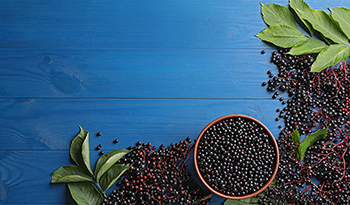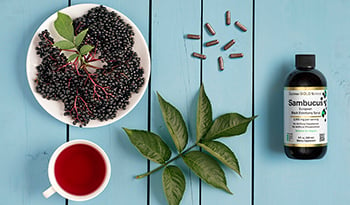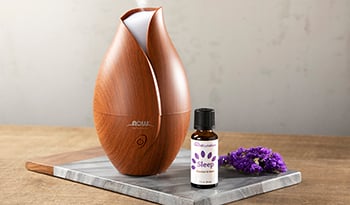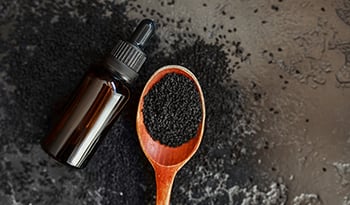Sore Throat? Try These Science-Backed Natural Remedies

A sore throat is a common ailment that we all experience at one point or another. Of the main causes for a sore throat, only one requires antibiotic medications. Prevention and treatment of the symptoms for most cases of a sore throat can take a natural approach.
Main causes of sore throat:
- Viral sore throat (infectious)
- Bacterial sore throat (infectious)
- Fungal sore throat (infectious)
- Allergy related (non-infectious)
- Acid-reflux related (non-infectious)
It’s important to figure out the cause of a sore throat. The most common infectious reason is viral infection. Sometimes, however, bacterial infections, or even fungal infections, can also result in an infectious sore throat. There are also two common non-infectious causes: irritation from postnasal drip (usually caused by allergies or food sensitivities), and acid reflux-induced inflammation and pain.
Common Symptoms of Sore Throats
The following symptoms can be common with all five types of sore throats.
- Redness
- Swelling
- Irritation
- Scratchiness
The pain is usually worse when food, liquid, and even saliva are swallowed.
If a sore throat is infectious, the following other symptoms may be present:
- Fever
- Headaches
- Swollen lymph nodes
- White spots on the tonsils
- Skin rash
- Muscle pains
- Joint pains
- Abdominal pain (usually seen only in children)
- Vomiting (usually seen only in children)
Treatment of a Sore Throat Depends on the Cause
Viral Sore Throat
A sore throat that is caused by a virus usually will resolve on its own within a week. However, if the pain is severe in nature or persistent, a doctor should be seen to ensure that symptoms are not the result of bacteria. A sore throat may also be present during a cold (upper respiratory infection) or influenza and will likely be accompanied by cough and congestion.
Teenagers are particularly susceptible to sore throats caused by the Epstein-Barr virus, also known as mononucleosis, or simply “mono”. This is a severe viral infection that can lead to joint aches, whole-body rash, fevers, spleen enlargement, and severe fatigue. It is important to note that antibiotics are not helpful when the cause of the sore throat is viral — if a person with a mononucleosis infection is given antibiotics, they will frequently develop a unique rash as a side effect. Mononucleosis symptoms can last up to four weeks before completely resolving.
Bacterial Sore Throat
The most common cause of a bacterial sore throat is streptococcus pyogenes, which is often referred to as strep throat. Gonorrhea and chlamydia, both of which are sexually transmitted infections, can also cause a sore throat and tonsillitis. Doctors frequently rely on key features to help diagnose bacterial sore throats. Strep throat is usually associated with the following:
- Fever over 101 degrees F (38.3 C)
- The absence of a cough
- White pus pockets or lesions on the back of the throat
- Tender lymph nodes
Treatment for bacterial infections includes antibiotics (again, it is important to note that antibiotics do not help viral or fungal infections). Rarely, an abscess in the tonsils may develop due to streptococcus or other bacteria. When this occurs, a minor surgical procedure may be required to drain that abscess.
Fungal Sore Throat
A fungal infection of the throat can occur in those with diabetes (fungus-like all the extra sugar) and those who are immunocompromised. It can also occur as a side effect of antibiotics, which can destroy the healthy bacteria in the mouth and throat. This type of infection is commonly referred to as thrush. Most of the time, treating the cause and/or taking antifungal medication is advised.
Allergy-Related Sore Throat
Those with chronic allergic symptoms frequently suffer from post-nasal drip, a chronic stream of mucus draining down the back of the throat. This will often lead to irritation and inflammation, resulting in pain or discomfort. Finding the component causing the allergic reaction is critical, and if the source is unknown, an allergist can be consulted. Anti-allergy treatments and sinus rinses may be helpful in lessening bothersome symptoms.
Acid Reflux Caused Sore Throat
Chronic acid reflux may lead to a scratchy voice and sometimes a sore throat. Making dietary changes and eating smaller, more frequent meals is helpful for many. A physician’s counsel should be sought if acid reflux symptoms last more than two weeks. Sometimes prescription medications are required. In a prior article, I discussed natural approaches to aid digestion concerns.
Conventional Approaches to Sore Throats
After identifying the cause of a sore throat, the following can be employed:
- Taking over-the-counter pain medicines (paracetamol, acetaminophen, ibuprofen, etc.)
- Gargling with warm salt water (1/2 teaspoon of salt in warm water. Caution: do not swallow)
- Using a humidifier
- Maintaining adequate fluid intake
- Avoiding acidic foods
- Avoiding tobacco smoke
Natural Approaches to Sore Throats
Natural approaches can also be taken. Note: these practices are not recommended as a treatment for those with bacterial or fungal infections. In those cases, a doctor should be consulted. However, the following may be beneficial in helping to strengthen the immune system and control symptoms.
The following treatments are primarily for those with viral infections. The recommendations may also help with symptoms of bacterial and fungal infections, but again, these conditions are best treated by a physician.
Echinacea
Echinacea purpurea is a perennial herb that has been used for almost 2,000 years with its origins being traced back to the indigenous people of North America. It has been used to treat respiratory infections and sore throats.
A 2015 study in JAMA showed that while there was no benefit in the prevention of a cold, the use of echinacea could shorten the duration of the illness. By extension, cold symptoms, including a sore throat, could also be lessened.
A 2016 study published in Holistic Nurse Practitioner demonstrated Echinacea could help prevent the common cold and, thereby, sore throat symptoms. Other studies have shown similar findings. Echinacea is frequently consumed as a tea, extract, or supplement.
Elderberry
Elderberry, a flowering plant, has been used for medicinal purposes for hundreds of years by native populations all over the world. In recent years, elderberry’s popularity has gained traction.
Within traditional medicine, elderberry has been used to treat arthritis-related pain. It has also been used by many to manage symptoms of colds. Elderberries have been used for generations by many in South America for medicinal purposes. Indigenous Americans have used elderberries as treatment for various infections and fever, while in Europe elderberry fruits have been made into syrups for medicinal purposes.
Studies measuring ORAC (Oxygen Radical Absorbance Capacity) values show elderberries have higher antioxidant levels than blueberries and cranberries, which are well known for their high levels of antioxidants and subsequent health benefits.
A 2016 study showed that elderberry could reduce the duration of cold symptoms in airline travelers, while a 2009 study in Phytochemistry showed that elderberry can perform similarly to the popular anti-influenza prescription medications oseltamivir (Tamiflu) and amantadine. Similarly, a 2014 study concluded that elderberry could be an effective treatment for the influenza virus. Sore throats are a common symptom in those with the flu virus.
Ginger Root
The scientific name for ginger is zingiber officinale, and its roots are known as zingiberis rhizoma. Ginger is a flowering plant originally from Southeast Asia, but its thick roots have been also used in traditional medical practices of China, India, Polynesia, and Africa. It is also a popular cooking spice.
In Ayurvedic medicine and Traditional Chinese Medicine (TCM), ginger is well regarded for its healing and medicinal properties. Its active ingredients are gingerol and shogaol.
In traditional medicine, ginger is highly respected as a treatment for viral upper-respiratory infections. Multiple studies have shown the root to be a COX-2 inhibitor, which allows it to play a similar role as NSAID drugs (ibuprofen, naproxen, indomethacin) and can reduce fevers and sore throats.
Additionally, ginger has been shown to produce anticholinergic activity within the respiratory tract. This property helps reduce mucus congestion within the chest and reduces cough symptoms, making ginger an excellent option to help treat the symptoms of a chest cold and influenza infection. It may also reduce sore-throat-related pain.
Green Tea
Green tea is the most consumed tea beverage in the world and second only to water as the most consumed liquid globally. After a major surgery, a sore throat is common due to the breathing tube used when a patient is put under.
A 2016 study in Anesthesia Pain Medicine showed that patients who had undergone open-heart bypass surgery had improvement in their sore throat symptoms, compared to the placebo solution, after gargling a green tea solution every six hours for one day after their surgery. The researchers believe the green tea’s anti-inflammatory effects helped reduce sore throat pain. A few other studies have shown similar results.
Honey
Honey has long been recommended around the world to help with coughs and other throat-related symptoms. A 2015 study evaluated honey’s benefit in reducing pain after a tonsillectomy, a surgical procedure to remove the tonsils. The results showed honey could be beneficial in reducing overall pain symptoms.
Licorice Root
A 2013 study in Anesthesia and Analgesia evaluated patients who had undergone surgery where a breathing tube was used. This study evaluated 236 patients. One half gargled with a sugar-and-water solution, while the other half used a solution of licorice extract and water. The researchers concluded, “Licorice gargling halved the incidence of sore throat. Pre-induction gargling with licorice appears to be a simple way to prevent a common and bothersome complication.”
Marshmallow Root
Marshmallow root (Althaea Officinalis) is an herb native to Western Asia, North Africa, and Europe. It has been used for medicinal reasons for millennia to treat digestive and respiratory issues. A 2018 study concluded that marshmallow root could be helpful in those with dry cough. The participants also had a sore throat. Marshmallow can be consumed as a supplement but also in a tea formulation.
Peppermint
Peppermint is a well-known herb, also available as an essential oil. A hybrid of watermint and spearmint, peppermint plants have leaves and stems that are mildly fuzzy, and tend to grow best in moist shady areas. Peppermint is native to Europe and has numerous health benefits. When consumed as a tea, it can be soothing to the throat. Its aroma may also help open up congested sinus passages when inhaled. Suggested dose: drink as a tea or use as an essential oil in a diffuser.
Throat Lozenges
Throat lozenges come in many formulations and can reduce cough symptoms and help to soothe a sore throat. However, many enjoy them even in the absence of an infirmary as their rich flavors can also serve as a treat. Common flavors include honey, eucalyptus, menthol, green tea, echinacea, anise, cherry, and many more.
References:
- Karsch-Völk M, Barrett B, Linde K. Echinacea for preventing and treating the common cold. JAMA. 2015;313(6):618–619. doi:10.1001/jama.2014.17145
- Holistic Nurse Practitioner. 2016 Jan-Feb;30(1):54-7.
- https://www.scientificamerican.com/article/what-are-orac-values/
- Nutrients. 2016 Mar 24;8(4):182. doi: 10.3390/nu8040182.
- Phytochemistry. 2009 Jul;70(10):1255-61. doi: 10.1016/j.phytochem.2009.06.003. Epub 2009 Aug 12.
- J Int Med Res. 2004 Mar-Apr;32(2):132-40.
- Mbaveng, A.t., and V. Kuete. “Zingiber Officinale.” Medicinal Spices and Vegetables from Africa, 2017, pp. 627–639., doi:10.1016/b978-0-12-809286-6.00030-3.
- Chrubasik, S., et al. “Zingiberis Rhizoma: A Comprehensive Review on the Ginger Effect and Efficacy Profiles.” Phytomedicine, vol. 12, no. 9, 2005, pp. 684–701., doi:10.1016/j.phymed.2004.07.009
- Rahmani, Arshad H et al. “Active ingredients of ginger as potential candidates in the prevention and treatment of diseases via modulation of biological activities” International journal of physiology, pathophysiology and pharmacology vol. 6,2 125-36. 12 Jul. 2014
- Anesth Pain Med. 2016 May 9;6(3):e32108. doi: 10.5812/aapm.32108. eCollection 2016 Jun.
- DeGeorge KC, Ring DJ, Dalrymple SN. Treatment of the Common Cold. Am Fam Physician. 2019;100(5):281–289.
- Abdullah B, Lazim NM, Salim R. The effectiveness of Tualang honey in reducing post-tonsillectomy pain. Kulak Burun Bogaz Ihtis Derg. 2015;25(3):137–143. doi:10.5606/kbbihtisas.2015.00008
- Anesth Analg. 2013 Sep;117(3):614-21. doi: 10.1213/ANE.0b013e318299a650. Epub 2013 Aug 6.
- Complement Med Res. 2018;25(5):299-305. doi: 10.1159/000489560. Epub 2018 Aug 1.
DISCLAIMER:This Wellness Hub does not intend to provide diagnosis...













































































 Table of Contents
Table of Contents
















